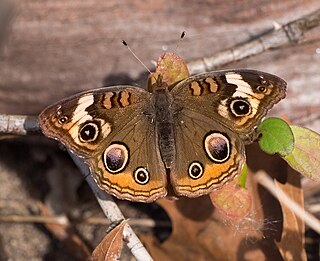
Junonia coenia, known as the common buckeye or buckeye, is a butterfly in the family Nymphalidae. Its range covers much of North America and some of Central America, including most of the eastern half of the US, the lower to middle Midwest, the Southwest, southern Canada, and Mexico. Its habitat is open areas with low vegetation and some bare ground. Its original ancestry has been traced to Africa, which then experiences divergence in Asia. The species Junonia grisea, the gray buckeye, is found west of the Rocky Mountains and was formerly a subspecies of Junonia coenia.

Parnassius clodius is a white butterfly which is found in the United States and Canada. It is a member of the snow Apollo genus (Parnassius) of the swallowtail family (Papilionidae). Its elevation range is 0–7,000 ft (0–2,134 m).

The pearl crescent is a butterfly of North America. It is found in all parts of the United States except the west coast, and throughout Mexico and parts of southern Canada, in particular Ontario. Its habitat is open areas such as pastures, road edges, vacant lots, fields, open pine woods. Its pattern is quite variable. Males usually have black antenna knobs. Its upperside is orange with black borders; postmedian and submarginal areas are crossed by fine black marks. The underside of the hindwing has a dark marginal patch containing a light-colored crescent.
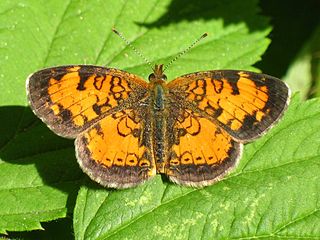
Phyciodes cocyta, the northern crescent, is a butterfly of the family Nymphalidae. It is found in the Nearctic realm.

Phyciodes batesii, the tawny crescent, is a butterfly of the family Nymphalidae that occurs in North America.

Phyciodes, the crescents or crescent spots is a genus of butterflies of the subfamily Nymphalinae in the family Nymphalidae.

Limenitis weidemeyerii, or Weidemeyer's admiral, is a butterfly from the subfamily Nymphalinae, found in western North America.
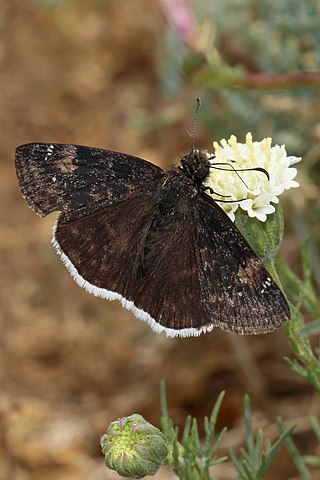
Erynnis funeralis, commonly known as the funereal duskywing, is a species of butterfly of the family Hesperiidae. It is found from southern United States, south to Argentina and Chile. Strays can be found north up to northern Illinois, north-eastern Nebraska, central Colorado, southern Nevada and central California.
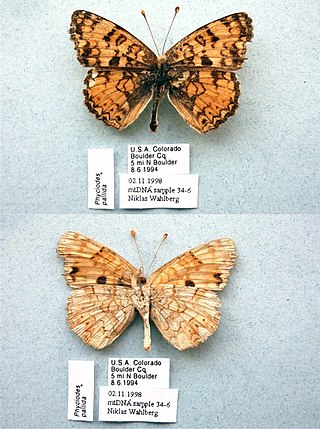
Phyciodes pallida, the pale crescent or pallid crescentspot, is a species of butterfly in the family Nymphalidae. It is found in western North America.
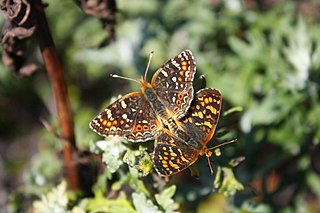
Phyciodes pulchella, the field crescent, is a butterfly of the family Nymphalidae. It is found in the Nearctic realm.

Chlosyne leanira, the leanira checkerspot, is a butterfly of the family Nymphalidae. It is found in North America from western Oregon south to California, Nevada, Utah and western Colorado, as well as Baja California. The wingspan is 33–40 mm. Generally, females are larger than males, but males have a more apparent red color to their wings.

Phyciodes phaon, the Phaon crescent or mat plant crescent, is a species of butterfly found in Florida, neighboring states, west to New Mexico and south to Cuba and the Cayman Islands where it is known as the crescent spot.

Phyciodes orseis, the Orseis crescentspot or California crescent, is a species of butterfly in the family Nymphalidae. It is found in western North America, particularly northern California and Oregon. Formerly, The range was thought to extend along the Coast Range as far south as San Francisco. However, they were either mislabeled or are currently extirpated from these regions. The habitat consists of mountain valleys, meadows and stream canyons. Along with roughly 120 other species, they are check-listed as butterflies occurring on or near the Fremont-Winema National Forests. This checklist has been established based on observations throughout Lake and Klamath counties in Oregon. The list is maintained by the Forest Service in order to monitor health of native ecosystems. Monitoring population levels of butterflies such as P. orseis over time provides a metric for these efforts. These pollinators play an integral role in such systems, as they are beneficial both for the flora of the region and as food sources for regional avian species.













